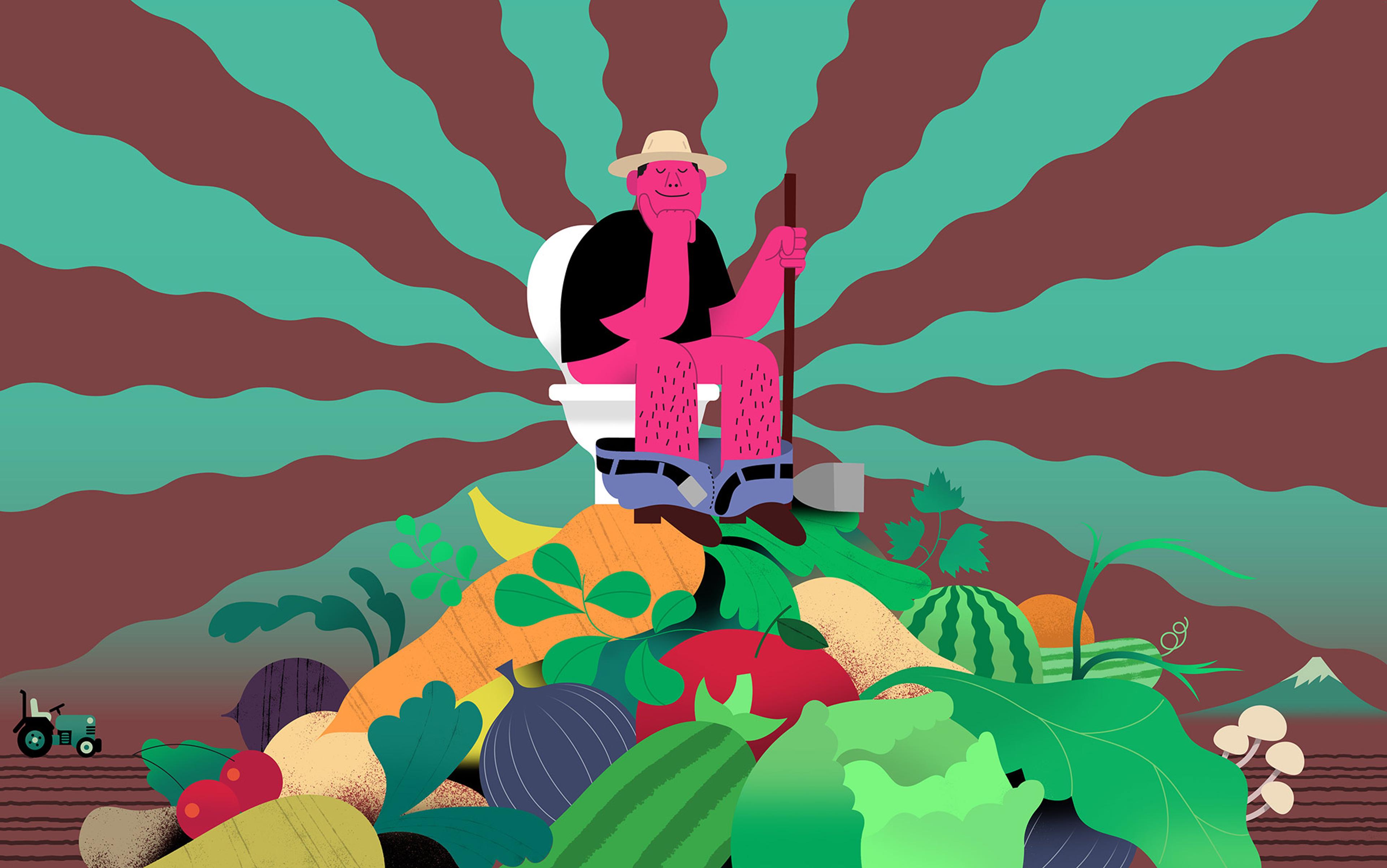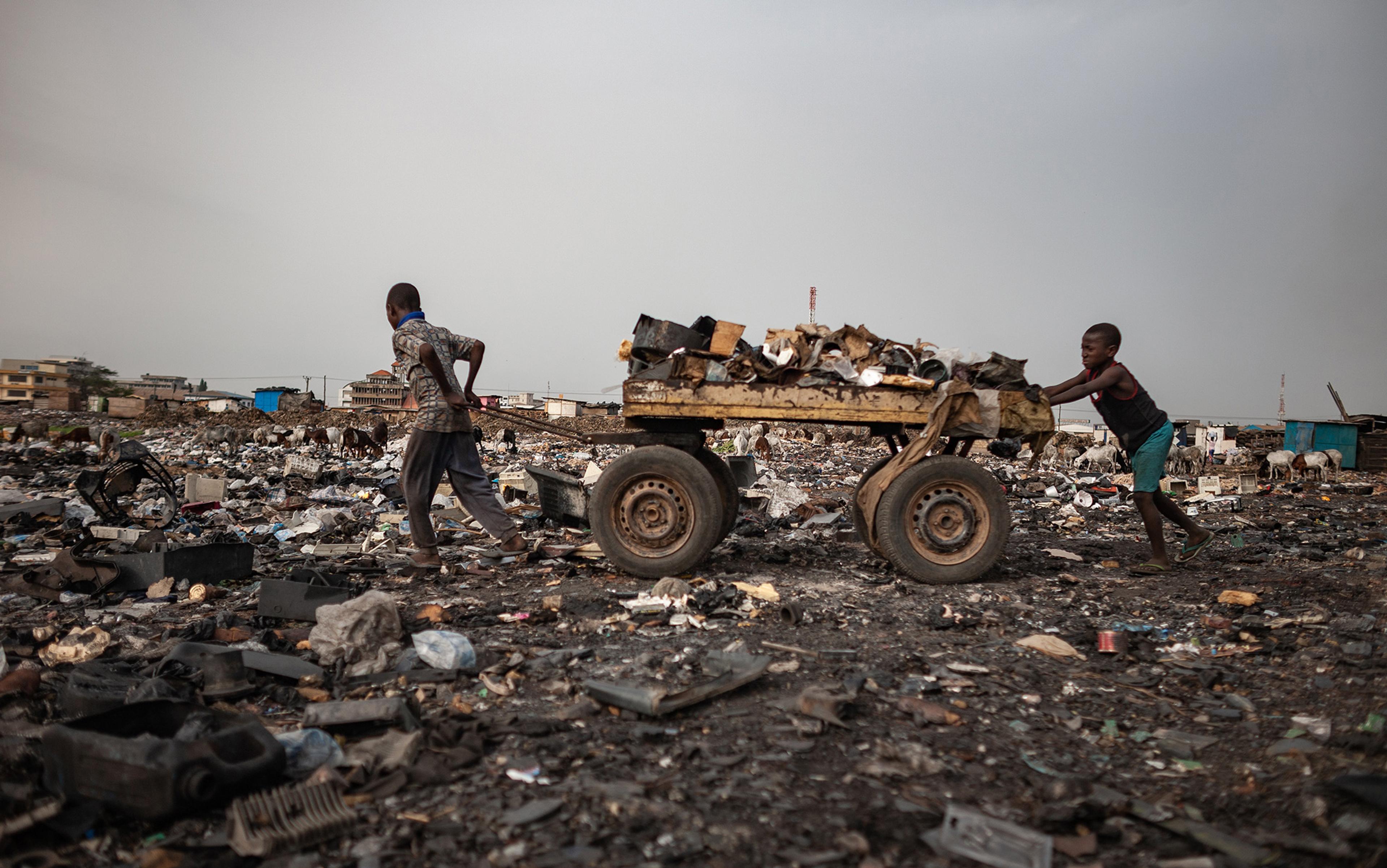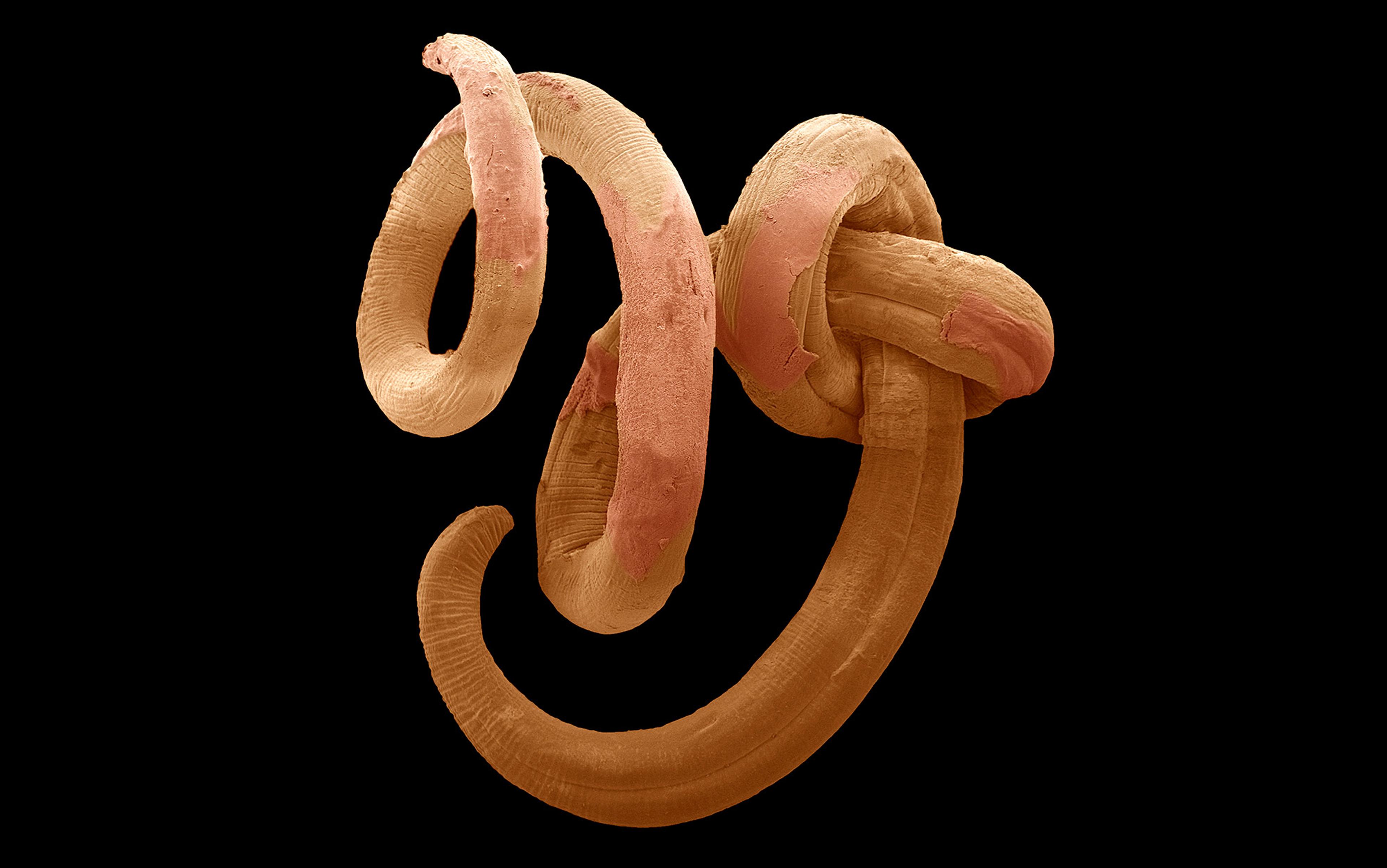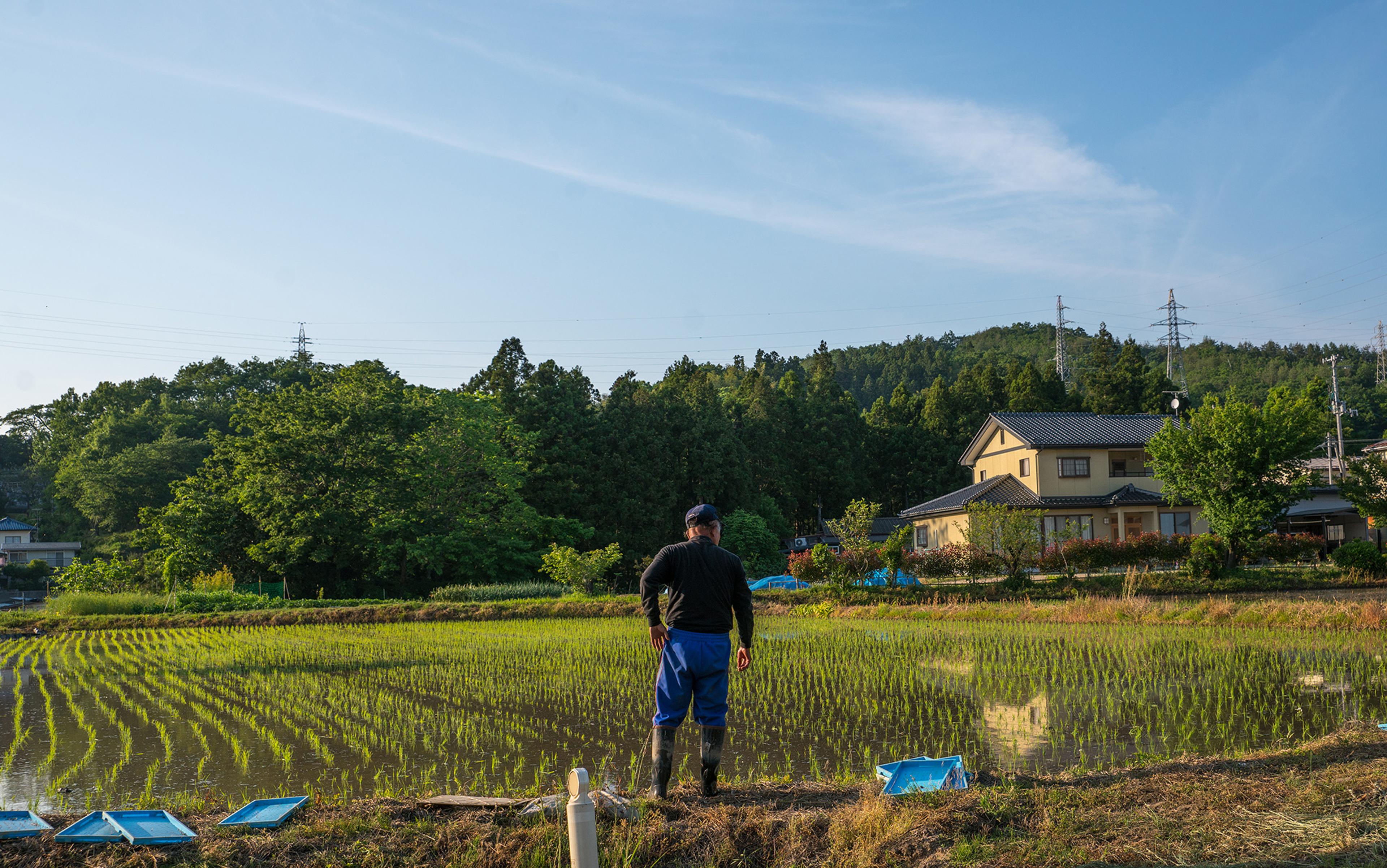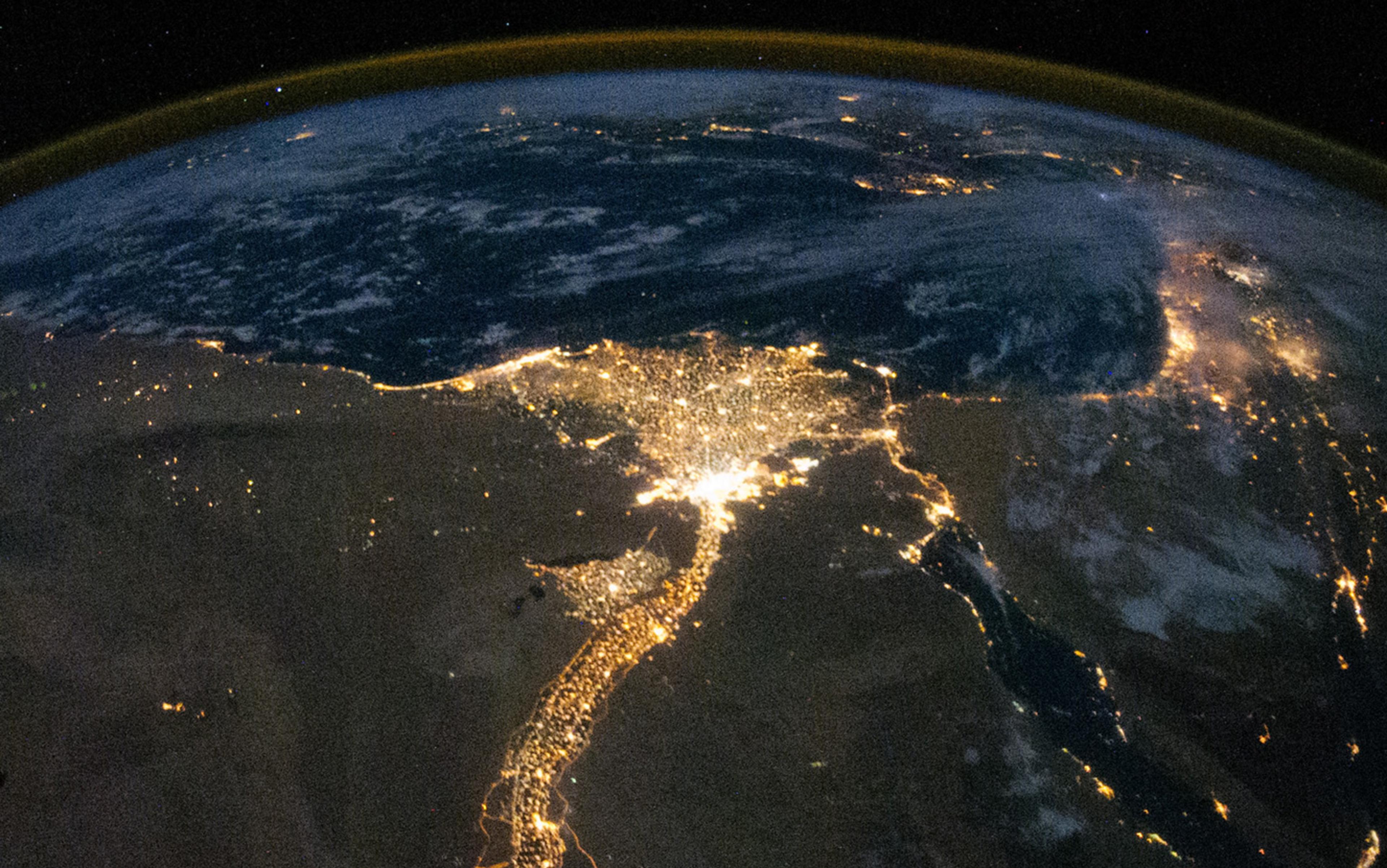Every fall when the grey sky over Kazan swelled with dark heavy clouds so full of water that the rain never stopped until it turned to snow, my grandfather prepped our small family farm for the long Soviet winter. He donned his sturdy overalls, heavy gloves and big boots – and headed over to our septic tank that held the sewage produced by our household for the entire year. He lifted its heavy lid, tied two old buckets to sturdy ropes, and spent hours transferring the tank’s content onto our land. Coming home from school, I could tell grandpa was doing our annual plumbing maintenance from a mile away. The smell travelled far and wide, mixing with other autumnal aromas – decaying leaves, wet dogs, and charred pig fat that people smoked for winter.
Despite its intensity, I was never disgusted by the smell. On the contrary, I was fascinated by the whole operation. It was a very special occasion that happened only once a season – like New Year’s Eve, my favourite holiday. You only got to open the pit once a year, like a big birthday present. And grandpa was the one and only special person who could touch it. I wasn’t allowed anywhere near the pit because my grandma was afraid of me falling in. The moment I’d start making my way to the tank, weaving through thorny bushes and stinging nettles, she’d materialise on the porch like a genie out of a bottle, screaming at me to ‘come back now!’ Oh, what wouldn’t I give to see the mysterious innards of our septic system. I’d kill to see its brick-lined guts full of brown goo. But I could only watch grandpa’s magic from afar.
Grandpa had a system of sludge distribution. He never filled the buckets fully so that, when he carried them, the sloshing goop wouldn’t spill over onto his boots. Sometimes he carried the buckets by hand, sometimes he balanced them on a koromyslo – an arched wooden pole placed over the shoulders to distribute weight evenly. He poked small holes in the tomato patches where the dried-up plants carried no fruit that sewage could contaminate – and poured the goo into them, covering the holes with soil. He splashed some around the roots of the apple and cherry trees and raked some leaves over so that, when we walked around, we wouldn’t get any on the soles of our feet. And he also dumped a bunch into one of the compost pits, adding it to the heap of other organic refuse. The compost pits were where Mother Nature forged its black gold. And there was a system to it, too.
The three composting pits operated on a rotating schedule. Throughout the growing season, the current pit would accumulate all the organic refuse we had – wilted flowers, pulled weeds, shrivelled stems of cucumber vines. In went our kitchen scraps too, like potato peels and mouldy bread. At the end of the season, he’d mix in the sludge and close the pit for a couple of years, leaving it to decompose and degrade. When he opened it two years later in the spring, all the dead and stinky stuff was gone. The pit was full of soft, rich and fertile dirt that smelled of nature, spring and the promise of the next harvest. That freshly made soil was fluffy and weightless like sugar powder, except it was black. The plants’ roots loved it and so did I. It felt so good to hold that soft soil in my palms – and transfer the tiny green tomato shoots into it. I could already smell their faint fragrance that would soon fully blossom into the crimson red fruit bursting with sweetness.
‘You have to feed the earth the way you feed people,’ my grandfather used to say. To me, it was such a beautiful statement, full of nature’s wisdom. We took from the earth, so we had to give back to it. Summers here were short and often cool and rainy, but in his orchard strawberries started turning red in June and tomatoes ripened all the way into September. And our apple and cherry trees bloomed and bore fruit year after year, fragrant in the spring and delicious in the fall. To me, this was the circle of life, and our excrement was as inseparable from it as we humans were inseparable from nature. It wasn’t ugly filth but potent fertiliser we carried within us.
Even our language constructs suggested that. In Russian, the word for fertiliser is udobrenie, a derivative of dobró, meaning good and rich. So the common toilet jokes revolved around that concept too. When my little cousins were being potty trained, we called the moment they had to go as giving out dobró or bogatstvo – the riches. I knew that other people, who lived in big apartment buildings, didn’t have septic tanks, but I was sure that their riches also went back into the soil somehow. If not, what would they eat? The earth couldn’t produce forever without being fed – it would grow barren. I thought the whole world lived the same way.
When I grew up – after the government took our farm, and we’d emigrated to the United States – I was shocked to learn that most people embraced a very different view of their metabolic output. For starters, they had no clue where their excrement went. They were also completely ignorant of its value. Moreover, they thought that the proper way to deal with it was to flush and forget – and they happily did both. The problem is that Earth just can’t process all that shit, and especially the way we’re dishing it out. We’re choking the planet with our poo.
An average adult produces about a pound (or half a kilo) of poo a day. That means that New York City, with its official census population of more than 8 million, pumps out more than 8 million lbs (or 4 million kg/4,000 tonnes) of excrement a day. Tokyo surpasses that slightly with 8.3 million lbs daily. China’s capital Beijing, a huge urban conglomerate of 21.3 million dwellers, beats NYC and Tokyo combined. Now imagine the mind-boggling piles of excrement that the planet’s 7 billion people generate in just 24 hours. Multiply it by 365 days a year, and it will likely make you gasp: Holy crap!
What do we do with all this poo? For the most part, we try to distance ourselves from it as much as possible. The exact mechanisms of that process depend on where you live. In the Western world, we flush it down the toilet. In the less fortunate places, it’s left to decompose in pit latrines or underneath trees. But no matter the country or the culture, the common thread is that we try to move our ordure as far away from us as we can. We’re universally disgusted by it. It’s excrement. It’s yucky by definition. It’s appalling by sight and smell.
There are reasons for that. Faeces are dangerous shit. When left to nature’s own devices, a pile of poo begins to endanger humans almost immediately. Attracted to the nutrients inside that pile – nitrogen, phosphorous and undigested proteins – pathogens swarm in. Some feed on it, others lay eggs. When faecal matter leeches into drinking water, it spreads cholera, dysentery and intestinal worms causing deadly disease outbreaks. So it’s hardly surprising that humans have a very complicated relationship with their own waste.
Our nomadic ancestors had it easy. They’d do their business during their rest stop and walk away from their precarious deposits. But when humans settled and began farming, they could no longer leave their dung behind, so they began accumulating it in pits or dumping it into rivers. Some of our Neolithic ancestors learned to flush early – in Skara Brae, a Stone Age village in modern-day Scotland, the dwellings had a primitive form of hydraulic toilet. Ancient Romans built communal toilets with thrones akin to ours; the unwanted substance would fall into a gutter where continuously flowing water carried it outside the city walls through sewage pipes. The residents of medieval Europe built latrines that accumulated their deposits in barrels, which were later sealed and buried underground.
We don’t drive, sail or fly to return this organic bounty to the land. We flush it down the drain
However, when people began aggregating in cities, shit really hit the fan. Dumping waste in a local body of water proved dangerous – the upstream residents simply polluted the drinking and washing water of their downstream neighbours, and triggered disease outbreaks. The infamous pandemics of cholera that swept through Europe in the 19th and early 20th centuries were started by faecal contamination of drinking water. Even today, diarrhoeal diseases sicken and kill about 827,000 people a year in the developing world, according to the World Health Organization. Estimates from the Centers for Disease Control and Prevention are even grimmer: more than 2,000 children die from diarrhoeal diseases daily – more than from AIDS, malaria and measles combined. In the developed world, we built flushing toilets, underground pipes and gigantic sewage treatment plants to protect ourselves from our massive excrement piles. Yet, these marvels of modern engineering have done significant damage to Earth’s ecology.
Scientists call this phenomenon the metabolic rift or the redistribution of nutrients on the planet but, conceptually, it echoes my grandfather’s earth-feeding notion. If you think where our food comes from, particularly in colder climates, you’ll realise it’s grown someplace else. As our bananas, apples, lettuce, corn and rice grow, they extract nutrients from the land. That food is then trucked, shipped and flown to where we live – and where we eat it and excrete it. Yet, we don’t return that organic matter back to where we got it from, like my grandfather did. We don’t drive, sail or fly to return this organic bounty to the land. We flush it down the drain.
Our local sewage treatment plants clean that water from pathogens, but not from the nitrogen, phosphorus and potassium this wastewater is rich in. These potent fertilisers usually flow into a body of water nearby, constantly overfeeding the lakes, rivers and the ocean. That results in toxic algae blooms, dead fish and decaying waterways, which are not biologically designed to absorb so much fertilising chemicals. Likewise, our Earth is not biologically designed to keep growing food without us feeding it.
So, because we don’t ship our shit back to where the food comes from, we keep perpetuating the redistribution of nutrients on the planet. Soils grow barren, so we use synthetic fertiliser, which isn’t anywhere near as good as the real shit, and also is very polluting to produce. In our quest to rid ourselves from our dangerous dark matter, we’ve broken the essential rules and laws of Mother Nature. By taking our poo out of the equation, we altered not only our agriculture, but the entire planet’s ecology.
Restoring that broken link is essential to our food security and healthy ecology. And to fix it, we have to figure out how to ship our shit back to where our food comes from. After all, my grandfather wasn’t the only one who knew that secret. Some of the thriftier ancient societies had figured out that ecological wisdom way before us. Once upon a time, faeces were very much in fashion, so we have some good examples to learn from.
In 1737, an emperor of the Qing dynasty in China issued a decree prescribing all his subjects to diligently gather their excrement and put it to good use. Dubbed the ‘night soil’ because it was usually collected in the wee hours of the morning when people put their chamber pots out the door, faecal matter was a booming business in Jiangnan province in southern China. Meanwhile, people in northern China weren’t as keen on it. And the difference was really striking, which is what prompted the emperor to write his treatise to begin with. ‘The streets in the north are not clean. The land is filthy,’ the document read. ‘The northerners should follow Jiangnan’s example. Every household should collect night soil.’ The final verdict, which became the decree’s title, was as plain as it was poetic: ‘Treasure Night Soil As If It Were Gold’.
There was a reason why the southerners were more adept at night soil collection than their northern brethren. They were home to some of the largest cities on Earth at the time. A major seaport, the city of Hangzhou counted more than 3 million people. Another massive urban sprawl, Suzhou at the Yangtze River, counted 6.5 million. All these people had to eat, so farmers had to grow a huge amount of produce, and thus every scrap of fertiliser was precious. Without using human faeces as ‘humanure’, they would never have grown enough food for everyone. The night soil collection was an important business and a very respectable one, as Donald Worster explains in The Good Muck (2017), his ‘excremental history’ of China.
The night soil collectors were called fenfu, and they wheeled their carts through the city streets emptying the residents’ buckets into wooden containers that held about 60 lbs each. The carts could fit six to 10 of them, accumulating up to 600 lbs in total. Those who wanted to break into the business but didn’t have the means to buy a cart, could start by carrying buckets on poles thrown over their shoulders – not unlike my own grandfather. The fenfu men had their designated daily routes where they picked up the fertile muck, and routes by which they took it out of the city. They loaded it into gondolas covered by straw to cut the stink and sailed it to the countryside. There, the city’s cumulative metabolic output was processed – spread, dried and sorted, according to its value. Not all of it was created equal. The offerings of the rich sold to the highest bidder because they ate better and thus released more nutrients. The poor people’s output cost less. Farmers who could afford the better riches opted for the more expensive fertiliser, which likely grew better produce, which sold for higher prices. Manure was money, so the farmers treated it as such, to the point that they stored it in burglarproof containers. If humanure was to be treated like gold, it had to be guarded as such, too.
Stealing shit was an offence serious enough that the authorities sent the felons to prison
In Japan, its value was, in fact, measured in gold. For instance, according to the Japanologist Susan Hanley, one ryō of gold bought enough grain to feed one person for a year. Meanwhile, the price of night soil produced by 10 households for a year was priced at half a ryō. The Japanese name for night soil was pithy and right to the point: named shimogoe, it literally meant fertiliser from the bottom of a person, according to Kayo Tajima, now professor at Rikkyo University in Tokyo. In the rapidly developing cities of Osaka and Edo (today’s Tokyo), this ‘person’s bottom fertiliser’ was in such high demand that governing bodies had to outline a strict system of its rights and regulations. For example, if a family rented a house, who had the rights to the excrement – the tenants or the landlord? It may seem logical that the tenants, who produced it, should’ve been the proud owners of their poo, but the preindustrial Japanese lawmakers thought quite the opposite. They bestowed the valuable shimogoe rights onto the landlords who sold it to the collectors, who in turn sold it to farmers. In some cases, farmers established tsuke-tsubo – direct contracts with the urban poo producers. The residents would promise the farmer all the poo they generated for a year in exchange for a certain amount of rice as a down payment. Grateful farmers sometimes thanked their contributors with gifts, like special rice treats, sometimes dubbed ‘dung cakes’.
The more affluent farmers established relationships with daimyo – Japan’s feudal lords who owned large estates and had many servants, thus generating a lot of shimogoe. The farmers supplied the estates with firewood and young plants for vegetable gardens in exchange for the privilege of collecting daimyo’s top-quality shimogoe. Daimyo and their domestic help ate well, so their night soil was very nutrient-rich.
It was not uncommon for farmers to fight over their shimogoe collecting privileges. In the summer of 1724, two groups of villages erupted in ‘poop wars’, fighting over the rights to gather night soil from different parts of Osaka. In response, the urbanites formed their own organisations that oversaw night soil trading and price negotiations – and they raised prices on their poo. Some of the poorer farmers found themselves in a great deal of trouble because they were no longer able to afford the fertiliser, which led to a crime unfathomable by our standards: stealing shit. It was an offence serious enough that the law-enforcement authorities sent the felons to prison, but that didn’t stop the desperate farmers from committing their stinky crime.
How did these societies evolve such a different view of human excreta? The answer was quite literally buried in the ground. Unlike European countries, rich with lush forests or green meadows, Japan was not blessed by wide stretches of fertile land. The country’s poor sandy soils didn’t naturally produce abundant crops. Before a newly created patch could yield some food, farmers had to work hard to nourish it, with every scrap of biomass they could find. ‘A new field gives but a small crop,’ states the old Japanese saying. Fertiliser from people’s bottoms was an easy and naturally occurring resource that never ran out, as long as there were people. Thanks to the fertiliser from their own bottoms, the Japanese converted their unfriendly rocky lands into flourishing fields. Similarly, the Chinese farmers managed to keep their soils fertile for generations, which to the farmers of European descent was nothing short of a miracle. European and American farm fields would start turning to dust sooner or later.
This phenomenon was so interesting that in 1909 the US agricultural scientist Franklin Hiram King travelled to Asia to learn the secrets of so-called ‘permanent agriculture’. When King came back, he wrote the book Farmers of Forty Centuries (1911), in which he suggested a few fertilising ideas, but the night soil business was likely too shocking to take off on the American continent. It took more than a century for the seeds of the idea to germinate into the now-widely discussed concept of ‘circular agriculture’ and the fact that our humanure can mend, or maybe rather fill, the deep metabolic rift we created.
Among environmentalists, the idea of returning humanure back to land is definitely sprouting roots. Yet, there are many practical challenges to making it happen. Would city residents trade their porcelain johns for chamber pots they’d put out the door for daily collections, along with their garbage bins? Or can wastewater plants pump city sewage into barges and sail them to Florida and California to fertilise farmlands? There is no one single solution that would fit every geographical locale. In fact, it will likely be a great diversity of sludge upcycling methods that will fix the redistribution of nutrients we created. Inspiringly, a few of them are happening already – some as little pilot operations and others on an industrial scale.
Fertiliser from the DC dwellers’ bottoms looks, feels and smells just like the garden in which I planted tomatoes
Loowatt, a startup based in the UK and Madagascar, follows the shimogoe playbook, almost to the tee. It sends a service crew to pick up waste from impoverished neighbourhoods in Antananarivo, Madagascar’s capital. Gathered and sealed in biodegradable bags kept underneath toilets, the waste is collected, heated to kill pathogens and loaded into biodigestors, where the microbial zoo chews through it the way it did in my grandfather’s piles, turning it into compost. In the process, the microbes also burp out biogas, which consists chiefly of methane, which Loowatt’s team burns to heat the sludge, in a self-perpetuating loop. Another startup, SOIL Haiti, works in a somewhat similar fashion, to restore the country’s depleted and eroded farmlands with people’s modern-day shimogoe. In places with water scarcity, manual poo pickups can be efficient and inexpensive sanitation solutions, saving two problems at once – keeping cities clean and feeding the earth.
There are ways to close the metabolic rift in the Western world, too. The Canadian company Lystek uses humongous blenders to whip sludge into a sewage smoothie that’s pumped into trucks that take it out to the country and inject it into the fields – a mechanised alternative to my grandfather pouring the brown goo into the earth. DC Water, a cutting-edge treatment plant in the US capital, takes poo repurposing to new heights. As the metabolic output of the 2.2 million people who live Washington, DC and the surrounding areas arrives, it is loaded up into massive pressure cookers where it simmers at 300°F (149°C) and six times the atmospheric pressure, which kills everything alive. The resulting stew is fed to the hungry microbes in huge concrete biodigester tanks with similar end products – the methane used to generate electricity and a black, liquidly goo. In an uncanny similarity to the fenfu men’s night soil processing, the goo is dried and packaged into bags, which are sold in local stores. Named Bloom, that fertiliser from the DC dwellers’ bottoms looks, feels and smells just like the garden dirt in which I planted tomatoes with my grandfather.
Personal biodigesters can be a boon for families living off the grid or in countries where energy costs are high. Manufactured by the Israeli company HomeBiogas, these small digesters are made of tough durable plastic, and can convert any type of organic waste into biogas and liquid fertiliser. Another solution, developed by the San Francisco-based company Epic Cleantec, works at the level of residential or office buildings. The plug-in units clean and recycle the buildings’ wastewater, so rather than flowing to the sewage facility, it can be reused for washing clothes, watering plants and flushing toilets. And the stinky leftover gunk is converted into fertiliser.
With so much smart tech, why haven’t we closed our metabolic rift? The problem is that we have to mend another huge fissure in the excremental ideology – not the metabolic but the mindset one. Unlike people in ancient societies, we still think of our excrement as the ultimate waste product that needs to be dealt with. We still don’t view it as an extremely valuable and versatile asset. We spend our efforts and money to remove the dangerous filth rather than to acquire and use a superb product of our metabolic bodies. And that’s the leap of thinking we must achieve, as a 21st-century society, to fix the problem fully.
We have to de-stigmatise our own dark matter. We have to think of it as a natural, fully renewable and sustainable resource, and praise ourselves as its potent producers – just like the thriftier societies did before us. We have to realise that poo makes good business and that there’s money to be made in shit. It’s just sitting there, up for grabs while we’re pinching our noses, looking the other way. Faeces is that final frontier that stays between us and circular agriculture, sustainable economy and proper nutrient replenishment. When business people and entrepreneurs are once again bickering about who gets to lay their hands on humanity’s oldest gross domestic product, we’ll know for sure that we have closed our metabolic rift.
